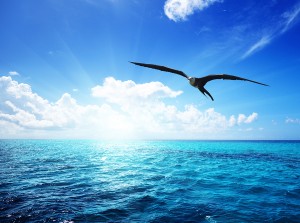Why is the world’s largest garbage patch in the ocean?
 Did you know the world’s largest garbage patch is in the ocean?
Did you know the world’s largest garbage patch is in the ocean?
And that it consists of what was once hailed as a great future?
In the 1967 film, The Graduate, starring Dustin Hoffman, the new college graduate is cornered by a friend of the family with advice for his future:
Mr. McGuire: I want to say one word to you. Just one word.
Benjamin: Yes, sir.
Mr. McGuire: Are you listening?
Benjamin: Yes, I am.
Mr. McGuire: Plastics.
Benjamin: Exactly how do you mean?
Mr. McGuire: There’s a great future in plastics. Think about it. Will you think about it?
Little did we know that the great future of plastics could turn out to be The Great Pacific Garbage Patch – and a persistent tragedy on our planet.
Sadly, very few people even know about it.
The Great Pacific Garbage Patch
A quick oceanography lesson:
A gyre is a naturally occurring vortex of wind and currents that rotate in clockwise direction in the northern hemisphere, and counterclockwise in the southern hemisphere.
There are five major oceanic gyres on the planet. The North Pacific Gyre is the largest ecosystem on Earth and it covers most of the Northern Pacific Ocean. It has a clockwise circular pattern formed by four prevailing ocean currents.
The whirlpool effect of the gyre collects plastic debris that has been discarded into the ocean. An ironic example of The Law of Attraction at work.
The “North Pacific gyre” is also known as the Great Pacific Garbage Patch.
It is full of man-made debris [mostly plastic] and is estimated to be at least twice the size of the state of Texas.
Swirling in the Pacific between California and Hawaii, it is the largest landfill in the world – floating in the ocean.
It is estimated that 11 million tons of floating plastic covers an area of 5 million square miles in the Pacific Ocean. Yes, that’s five million square miles.
The plastic is petroleum-based, making it full of chemicals and pollutants. Scientists refer to it as “toxic soup.”
The main problem with plastic, aside from the sheer volume of it, is that it is not biodegradable. That means, the plastic is there to stay –for hundreds of years.
However, it is photo-degradable, meaning it breaks down in the sun into smaller pieces of plastic.
These small pieces are mistaken by marine life for edible phytoplankton. So they eat it, yet cannot digest it, leaving no room in their bodies for real food.
They end up dying of starvation.
At least a million birds and marine animals die each year from consuming plastic or becoming caught in plastic debris.
The 19 islands of the Hawaiian archipelago receive massive quantities of plastic from the Gyres. Some beaches are buried under 5-10 feet of trash!
Approximately 80% of this plastic originates on land and 20% comes from recreational boaters, maritime industries and the military.
Is there a solution to the garbage patch?
Scientists are trying to rise to the challenge of cleaning it up, although some say it’s impossible to thoroughly clean a section of ocean the size of a continent and 100 feet below the surface.
Possibly the next best solution is to stop contributing to making it larger. Here’s a list of actions you can take:
1. Replace your use of plastic bags —bring canvas shopping bags to the grocery store. Most plastic is petroleum based, thereby adding to our demand for oil.
2. Bring lightweight cloth bags for your produce, rather than plastic bags. Search for cotton veggie bags – there’s a large selection out there.
3. Stop buying individual bottled water. [Some cities have banned their sale]. Buy a BPA-free water bottle and refill it from a home purification system. I keep a two-gallon BPA-free jug of pure well water in my car for refilling my water bottle when I’m out and about.
4. RECYCLE what plastic you do have.
5. Encourage your government to enforce international treaties that prohibit dumping garbage in the ocean.
6. Start a movement in your community to eliminate the use of plastic bags. Many communities around the world have done so. The first in the world was Bangladesh in 2002 after finding that plastic bags clogging their drainage systems was responsible for the 1988 and 1998 floods that submerged most of the country.
7. Lobby companies and your governments to find alternatives to plastic.
8. If not a ban, support a tax or fee on plastic bags. In Italy, Belgium and Ireland, plastic bag use dropped 94% within weeks of a 2002 tax.
If the above hasn’t inspired you to act, I believe this four minute film should provide plenty of incentive.
Thank you for doing what you can to keep plastic out of our waters and wildlife.
Sources for this article:
http://www.latimes.com/news/la-me-ocean2aug02,0,4917201.story#axzz30D6mUaSy
http://people.howstuffworks.com/how-many-cities-have-a-ban-on-plastic-bags.htm
Molly Larkin is the co-author of the international best-seller “The Wind Is My Mother; The Life and Teachings of a Native American Shaman” and other books on health. She is passionate about helping people live life to their fullest potential through her classes, healing practice and blog at www.MollyLarkin.com

